The Doge's Palace is the luxurious residence of the ancient Venetian government.
In the middle of the XIV Art. the Venetians elected eighty-year-old Marino Faliero, who was in the capital of Italy at that time, as their doge. When the newly elected ruler arrived at the Doge's Palace, his boat docked at the place where criminals were usually executed. This did not bode well.
Indeed, the elder married to a very young woman turned out to be rather jealous. Therefore, when during the holiday he noticed that the young Mikel Steno kissed his wife, he kicked the young man out of the palace. The young man did not immediately leave the celebration: he decided to wander a little around the palazzo and, finding himself in the "Hall of the Council of Ten," wrote offensive words on the armchair of the old doge.
When the inscription was found, it was not difficult to establish the culprit and the young man was arrested almost immediately. Despite the fact that Mikel Steno had to spend two months in prison, after which he was banned from entering the city for one year, the insulted Doge was not satisfied with the sentence. To take revenge, he decided to eliminate all members of the High Council and take all power into his own hands.
True, his idea was not crowned with success, since the news of the plan instantly reached the Supreme Soviet. Therefore, on the day of the coup d'état, Marino Faliero was arrested, and two days later he was beheaded on the Ladder of the Giants.
The Doge's Palace is located in Venice, on the mainland of eastern Italy, at a distance of 395 km from the capital of Italy, Rome, at the address: San Marco, 1, 30124 Venezia. On the geographical map, this unique architectural monument can be found at the following coordinates: 45 ° 26 ′ 0.8 ″ s. latitude, 12 ° 20 ′ 25.48 ″ E etc.
For many centuries, the Doge's Palace (Palazzo Ducale) was one of the main buildings of Venice: not only the Doge's chambers were located here, but the government of Venice was also in session. Supreme Court, The Senate, the Ministry, was the office of the chancellery, the secret police, the inquisition, as well as the naval department, law offices and other institutions.
The Doge's Palace acquired its modern look only in the 15th century. In the ninth century, an ordinary fortress was built in its place. A hundred years later, as a result of the uprising, the building was burned down and a new fortification was erected, which also burned down in 1106. But the building, built after this fire, was no longer a fortress and stood until decayed - in its place it was decided to erect a new building, the Doge's Palace.
The new building was also unlucky: after a hundred years, fire destroyed an entire wing of the palace, and it had to be rebuilt (the work was entrusted to Antonio de Ponti, under whose leadership the most talented architects of Italy worked).
During the construction of the palace in the history of Venetian architecture, there was just a transition from the Gothic to the more harmonious forms of the Renaissance, when architects began to abandon the harsh Gothic and began to give preference to rounded architectural forms. Despite the light and light appearance, the facade of the Palazzo also has a gloomy moment: between the ninth and tenth columns of the second floor (they differed from other pillars in a more intense red shade) death sentences were announced.
As a result, the Doge's Palace turned out to be massive, light in appearance (an important role in this was played by the openwork arches of the palazzo) and an upside-down foundation. This happened because of the shape of the facade: a huge solid wall was installed on the seemingly weak supports, which gave the building interesting compositional contrasts.
What the Palazzo Ducale looked like
The Doge's Palace could be accessed through the front gate of Porta della Carta (translated as "Gate of Paper"), made in the form of an arch and decorated with Gothic elements. According to one hypothesis, the name is associated with the scribes who executed various papers and documents here. 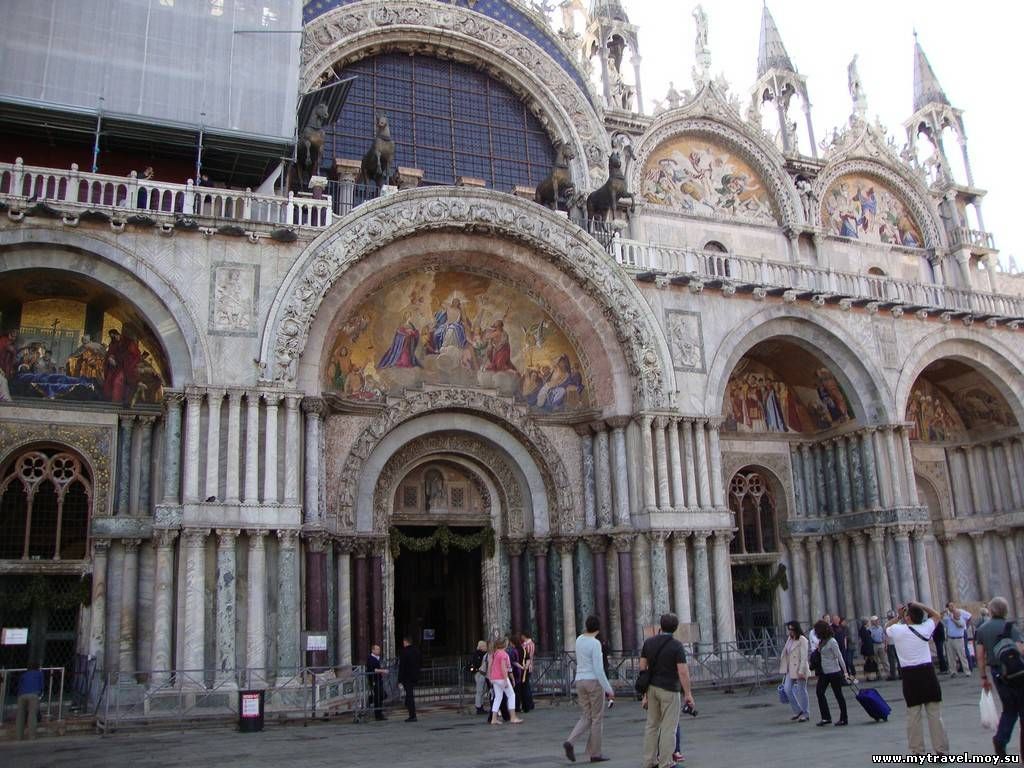
According to another version, the gate got its name thanks to the archive stored in the building. Above the gate was a sculptural composition depicting one of the Venetian rulers, Francesco Foscari, kneeling before the winged lion of St. Mark, there was a statue of Themis above them.
Immediately behind the gate was a courtyard surrounded on all sides by marble arcades and decorated with eight antique statues... Inside the courtyard, the architects built two wells made of bronze, in which the cleanest water in the city splashed.
Balcony
The balcony equipped on the side of the main facade was a tribune on which the ruler of the Republic appeared before the Venetians during the great celebrations (it is interesting that it was from this balcony in the middle of the 19th century that the unification of Venice with Italy was announced).
The stairs of the Palazzo Ducale
Here, in the courtyard, there was the marble Staircase of the Giants, at the top of which the Doges were crowned (it was named so because of the two large sculptures of Mars and Neptune installed on it, symbolizing the military power of the Republic).
The “Golden Staircase”, which got its name thanks to the gilded stucco molding, led to the ceremonial rooms of the palazzo. Only very important guests could climb it, as well as Venetians from noble families, whose names were written in the "Golden Book", which was kept in a special room here under the stairs. It is interesting that the Venetians compiled this book in the XIV century, having written in it two hundred families who had the right to apply for important positions.
In the Hall of the Grand Council, the patricians discussed state issues. This room is 56 m long, 25 m wide and 5 m high, and is the largest room in the world, the ceiling of which is not supported by any support.
The decor of this room was also striking: on its walls there were paintings by Titian, Veronese, Tintoretto, and on the ceiling - one of the largest paintings in the world - "Paradise", a work done in 1590 by Domenico and Jacopo Tintoretto.
Election Hall
Passing the Hall of the Grand Council, the patricians found themselves in the Hall of Fate (also called the Hall of Election). In this room, officials were publicly elected or condemned, and sentences were passed (it is interesting that no one had the right to enter the room with a weapon).
The room intended for the Council of Ten could be accessed from the Compass Room, in which the Inquisition was located (in the same room, the convicts were awaiting a verdict). The Council of Ten consisted of the Doge, ten Grand Council representatives and six Councilors, and dealt with crimes against the Republic of Venice.
On the walls of this room are portraits of almost all the rulers of Venice, except for one: where the image of Marino Faliero should have been, you can see an empty frame with the inscription: "A place for Marino Faliero, who was executed for treason."
Jail
The prison cells, located on the very last floor, were entered by a secret staircase. This part of the palazzo was usually called the "Lead Roof" ("Leads"): in the summer the convicts suffered from the heat, in the winter - from the cold. The doorways of the cells were so low that even a ten-year-old child could get inside, having previously bent over. 
In addition to these chambers, the dungeon was also equipped in the underground - there were nineteen underground chambers, called "wells", since they were located below sea level, through the barred window openings not only light penetrated, but during the rain the chambers were flooded with water. Convicts, if they did not want to spend whole days standing in the water, were often forced to sit on a mattress.
The food was also bad: in the morning the prisoners were given water and a piece of bread, while the bread had to be eaten almost immediately, otherwise breakfast threatened to fall prey to rats. It is interesting that in the lower dungeon there was a closed prison courtyard, from which, of course, there was only one way out - back to the cell.
When there were too many prisoners and there was not enough space for them, the Carceri prison was erected near Palazzo Ducale, through which one could get from the palace via the Bridge of Sighs.
Escape of Casanova
Interestingly, for many centuries, escape from the prisons of the Doge's palace was considered impossible. So, it was until Giacomo Casanova was in his dungeons (he was accused of communicating with spirits, heresy, debauchery and even stealing wallets).
The adventurer was placed in Leads, where he spent about a year working out the details of the escape. To do this, he even managed to poke a hole in the floor through which he planned to go down to the lower hall. He was unlucky: when everything was ready, he was transferred to the next cell. It is interesting that the jailer, having discovered the hole, did not report this fact to the authorities, since Casanova threatened to accuse him of complicity.
The second escape plan was more successful. Casanova, along with a neighbor, punched a hole on the roof of the palazzo. After that, they climbed up, then through one of the windows they found themselves in a room of the palace and, bypassing the guards, left the Doge's Palace (this is the story this adventurer described in his memoirs).
Is it possible to come to Venice and not visit one of its main attractions - the incomparable Palazzo Ducale, often called the Doge's Palace. Italy sacredly preserves the cult state object, and does not spare funds for its reconstruction. Monumental architecture, fascinating history and fabulous interiors await every visitor to this illustrious Venetian landmark. The most complete and interesting information you will find about the Doge's Palace in Venice in our article.
Historical reference
In the past, the Republic of Venice was considered a prosperous state. In its possession were the Ionian Islands, Cyprus and Crete, Istria, Dalmatia, Illyria (the territory of almost all of Yugoslavia). The Turks did not threaten the state, the Arabs did not have a developed fleet. Venice was active in trade with eastern countries all the way to India. The entire Mediterranean Sea belonged to a powerful republic.
The rulers of the Venetian state were called doji. Like all ruling persons, republican monarchs sat in a special building - the palace, where various receptions, meetings and councils were held.
Note: Citizens applying for the position of Doge had to have a high status in society, and come from a noble Venetian family.
Initially, on the site of the palace there was a fortress, erected in 810. Defensive structure it had walls and towers, it was surrounded by water on 4 sides. In 976, the fortress was burned down by the disgruntled people and some representatives of the local nobility, who rebelled against the ruling doge P. Kandyadi IV. Another fortress was erected on the site of the burned down residence, but it also suffered the fate of its predecessor - the building burned down in 1106.
In the XII century, a new one appeared in Venice luxurious palace... At that time, the need for the construction of fortress walls and forts disappeared. Now the sea became the protection for the palace, and instead of forts, the republic had a reliable combat-ready fleet. In this regard, the builders filled up the old moat, and erected the first Doge's palace in Venice.
The building that we can see today was erected in the years 1309-1424. The very first creator of the palace of the rulers was Filippo Calendario, who worked with the architects Enrico and Pietro Bazeio. 90 years later (in 1400-1404) the facade was built, facing the side of the lagoon, and in 1424 the next facade was completed, "looking" on the square of St. Brand. The completion of the construction work was carried out by Lombard, Venetian and Florentine architects. A significant proportion of the Gothic component of Palazzo Ducale was made by Venetian architects - the famous Bon family, who were reputed to be first-class marble craftsmen.
In 1577, the Doge's palace was badly damaged due to the destructive effect of the flame. During the restoration work, it was decided to recreate the cult object in its original form (despite the fact that the Renaissance architecture flourished in the 16th century). Gothic remained the dominant style of construction.
Note: the fire of 1577 not only damaged the palace building itself, but also destroyed the valuable masterpieces of the Venetian artist Giorgione.
Main residence Venetian doges- the palace on the square of St. Mark, carried out his state functions until 1797. At the end of the 18th century, the French conquered the republic. Napoleon and his troops occupied the city, and when leaving, they took with them several valuable works of art.
Today, Palazzo Ducale serves as the main city attraction and museum, where you can see various art exhibits, elements of weapons, globes, maps, etc.
The architecture of the Doge's palace
The Doge's Venetian Residence is a 3-storey U-shaped palace with 2 facades and built of pink, white and gray marble. The named landmark can hardly be attributed to any specific architectural style, however, it is the late Gothic style that is recognized as the dominant feature.
The first floor of the object is a gallery with pointed upward arches resting on columns. The arcade gallery performs an important function, saving visitors to the palace from the merciless Venetian sun. The second floor is an extended row of narrower and higher columns. In its upper part there is a row of boxes, decorated with an intricate ornament depicting a yarrow. The last, third floor is a wall covered with white marble. The smooth surface is dotted with large window openings and small windows.
Note: the upper massive part of the attraction stands on small openwork arches. The viewer who sees this spectacle for the first time will think that the palace is in an upside-down state: from above - the foundation, from below - the roof.
Both facades of the Doge's Palace were decorated with marble in the 15th century. During this period, the Venetians abandoned the Gothic tunes, and decided to "re-equip" the residence of their rulers in the style of a harmonious Renaissance. On the southern façade, there is the Doge's tribune, which is a beautiful balcony, above which stands the Monument to Justice, the brainchild of Alessandro Vittoria. From this balcony, the inhabitants of Venice learned that the city was united with the rest of the Italian kingdom.
Along the entire perimeter, the wall of the object is decorated with white battlements made of marble. The Doge's Palace has two main entrances:
- Paper Gate (or Porta Case Card)... They are considered the main entrance to the palace. The creators of this architectural masterpiece are Bartolomeo and Giovanni Bon. The paper gate is in the form of an arch with decorative arrows, the upper part of which is decorated with Gothic architectural elements. On the portal of the entrance is the Doge Francesco Foscari, in front of him is a winged lion, above - the statue of Justice.
- Wheat Gate (or Porta del Frumento)... This entrance is located on the side of the embankment. It is from the Wheat Gate that most of the excursion tours around the palace begin.
Internal premises of the object
You can get inside the palace by two staircases: Giants and Golden. The Giant's Staircase will lead visitors from the courtyard to a covered gallery on the second floor. It is made of Carrara marble. In 1554, two large sculptures of Neptune and Mars appeared on the stairs, which gave the name to the entire object. It was on the staircase of the Giants that the main events of the Venetian Republic took place, including the wedding of the doge.
The Golden Staircase was designed by Master Sansovinno especially for the Doge Andrea Gritti. The completion of the construction was carried out by Scarpanino. The staircase is decorated with gilded stucco molding. Only noble persons could walk along it.
The Doge's Palace has a large number of interesting rooms. We will tell you about them in more detail.
- Hall of the Grand Council. This huge room can be accessed via the Golden Staircase. The Council Room is the largest not only in Palazzo Ducale and Venice, but in all of Italy. Its height is 15 m, length - 54 m, width - 25 m. A huge hall occupies the entire southern wing of the building. Its windows overlook scenic landscape urban lagoon. Before the fire of 1577, its walls and ceilings were decorated with creations by Veronese, Titian, Tintoretto and other famous masters. Antonio de Ponti was involved in the reconstruction of the burnt-out building. The thrones of the ruler of the republic and members of the Small Council are located at the eastern wall of the hall. Above the places of noble persons, there is a large painting "Paradise", created by Jacopo and Domenico Tintoretto (1590). The ceiling of the Council Chamber is decorated with a large oval painting "The Triumph of Venice" by Paolo Veronese. Also on the ceiling are a large number of picturesque paintings framed with heavy patterns. Today, in the Council Chamber, you can see portraits of the ruling Venetian doges: everyone except Marino Faliero. His image is represented by a black scroll on which is written: "The image of Marino Faliero, who lost his life for treason."
- Hall of the Council of Ten. During the Venetian Republic, this room served as a meeting place for a tribunal, whose functions were to consider political cases committed against the state. At the head of the tribunal was the ruler of the republic (doge), also 10 members of the Grand Council and 6 additional advisers belonged to him. In the central part of the hall there is a painting "Zeus strikes vices with lightning." Today we can only see a copy of this masterpiece, and the original was withdrawn by the French in 1797. Since then, the painting is located in Paris, in the world famous Louvre. Above the Council of Ten was a prison called Piomba. They can be accessed via a special "secret" staircase. At one time, G. Bruno and Giacomo Casanova were imprisoned here. The cells were equipped with a leaden ceiling, for which they were nicknamed "Leads" and "Lead Roofs". The walls of the corridors still have low and cramped openings into which a teenager can hardly squeeze. The gratings and shutters were removed from the palace, but the dark past of the premises is reminiscent of the remnants of wooden paneling, which were designed to absorb moisture.
- Election hall. In another way, this room is called the Hall of Fate, tk. it was here that the nobility ran for office, their condemnation and sentencing took place. The ceiling of the Election Hall is decorated with gilding and carvings. Also on it you can see Padovanino's allegorical paintings, which are framed by frames in the form of ovals, irregular geometric shapes - triangles and squares.
- Hall of the Senate. It was attended by members of the Senate - the second most important Venetian state order. Senators were allowed to wear purple robes. Just like the hall of the Great Assembly, after the fire, the Senate room was restored by Antonio de Ponti. The ceiling painting is the work of Christopher Sorte. The panels in the Sorte ceiling were painted by several artists, including Tintoretto.
- Hall of the college. This room was intended for the meetings of the College, which included the Doge, the foremen, the Council of Ten, 6 councilors and the Supreme Chancellor. The appearance of the Collegium Hall is dated 1574. The same Antonio de Ponti was engaged in its arrangement. The ceiling of the room is decorated with gilding and carvings. Its creator is Francesco Bello. There are several allegorical paintings by Veronese on the ceiling, the most notable of which is "Venice on the Throne", located above the podium.
- Scarlatti Hall. The premises were intended for dignitaries who were expecting the ruler to hold official state events. The decoration of the hall is impressively luxurious. Most of the decoration of the room is the merit of Pietro Lombardo. The ceiling of the hall is made of wood and was created at the beginning of the 16th century. Also here is the heraldic sign of the Doge Agostino Barbarigo, located on an elegant marble stone.
- Compass room. In the past, the named room was the front hall of the Council of Ten and the "room of the inquisition", tk. in it the convicts were awaiting the sentence passed by the official. Also in the compass hall there was a "lion's mouth" - a place for collecting denunciations and other popular messages. The ceiling of the room has 3 large ovals and 12 rectangles to fill the corners. One of the ovals depicts the painting "The Triumph of Venice" by Paolo Veronese. Earlier on the ceiling there was a painting “St. Mark surrounded by saints ”, but in 1797 it was taken away by the French and exhibited in the Louvre.
- Hall of cards. An impressive space, named after the maps that adorn all the walls. The hall of cards was designed by Giovanni Batista Ramusio (16th century), Giustino Mennescardi and Francesco Grisselini (18th century). There are 2 globes in the middle of the room big size which were created in the 17th century.
- New Prison (Karcheri). The creator of this room is Antonio de Ponti. The new casemates can be accessed from the halls of the Office of Criminal Cases and the Office of Laws. After taking a walk along the corridor, the visitor will come out to the famous Bridge of Sighs, under which the Palace Canal flows. The bridge has 2 corridors: the lower one leads to the portico floor of the building, and the upper one leads to the new prison cells. In one of the rooms of Karcheri, Byron himself voluntarily spent the night. He hoped to feel the emotions experienced by the prisoners of the Doge's palace.
Note: the old prisons of the Palazzo Ducale were called Piombi (we have already told about them), and Pozzi (translated from Italian - wells), which were at the water level of the Palace canal. The most dangerous criminals were imprisoned in them.
Opening hours of the Palazzo Ducale
The Doge's Venetian Palace can be accessed throughout the year, with the exception of December 25 and January 1. The opening hours of the facility depend on the season:
- from April to October (inclusive), the palace is open from 8:30 to 19:00. Tourists are allowed inside until 18:00.
- from November to March, the attraction is open from 8:30 am to 5:30 pm. Get into indoor spaces possible until 16:30.
Please note: from 10 am to 2 pm rush hour begins in the palace, when most of the visitors are eager to get acquainted with the iconic Venetian landmark. Seasoned tourists plan a guided tour of the palazzo in the morning and afternoon.
Entrance fees to the Doge's Palace
How much does it cost to visit the famous Palazzo Ducale in Venice? The cost of inspecting a magnificent building depends on several factors. Note that the generally accepted price tag for a ticket for one adult is 17 euros, but the administration of the palace offers its guests a lot of lucrative offers.
- For student and school groups, the cost of tickets will be 5.5 euros if they plan to inspect the object from September 1 to March 15. The composition of the group and the time of visit must be agreed with the administration.
- Children 6-14 years old, people over 65 years old, students 15-25 years old, as well as citizens accompanying student and children's excursion groups have the right to purchase a ticket for 10 euros.
- Children under 5 years old, a disabled person and 1 accompanying person can visit the famous palace for free. When placing a group order for an excursion of 15 people or more, 1 of the tourists can go inside for free, but subject to the advance payment of the agreed amount in advance.
Special offers
- Each tourist is offered an excursion program with a tour of the secret places of the Doge's palace. For such a pleasure, you will have to pay 20 euros (with a discount, a visitor can count on a ticket for 14 euros). This tour is for groups of 2 to 15 people.
- The administration of the palace meets the thrill-seekers halfway and offers to use the service "inspection after closing". There is no fixed cost of such an event, all the details of the excursion are discussed in advance (namely, 5 days in advance), while the administration takes into account the wishes of visitors and their number.
Note: You can purchase a package ticket that includes visits to all 4 museums in St. Brand. However, keep in mind that with such a ticket, you will not be able to see the secret visits to Palazzo Ducale.
- On the bright facade of the palace (which overlooks the Piazzetta), in the second tier, you can see two burgundy marble columns. The reddish tint was not given by accident: it was here that the death sentences were announced to prisoners.
- Sculptures of winged lions with books can be seen in almost every part of the building. They are considered symbols of the patron saint of Venice, St. Brand. The muzzles of animals, as well as distorted allegorical faces, performed not only a decorative function. Denunciations were sent into the holes of architectural forms, which were considered by the Council of Ten. "Official documents" were those papers that had the signature of the compiler, as well as several signatures of witnesses.
- The golden staircase leading to the state rooms of the palace was built in 1538-1559. Until 1797, only members of the Grand Council could use this route, whose names were recorded in the Golden Book kept under the stairs.
- Why the main entrance to the palazzo has the name "Paper Gate" is still not known for certain. However, there are several opinions in society. For example, that these gates were constantly advertised that they were located next to the archival building, and also thanks to the scribes who helped the Venetians to draw up documents, petitions and complaints.
- The electoral hall is a special place in the palace, in which the fate of individual citizens, as well as the entire republic, was decided. It often passed sentences, but no one was allowed to enter the premises armed.
- Palazzo Ducale had several secret rooms. These included 3 prisons (Pozzi, Piombo and Carceri), the Council of Three hall, the execution hall, the torture hall, etc.
- The bridge of Sighs, connecting the object of the palace and the New Prisons, did not get its name by accident. Within the walls of the covered bridge there are small windows, from which the convicts could see the city for the last time and breathe, lamenting their unenviable fate.
A visit to the Doge's Palace is a must for all tourists visiting Venice. Walking through the majestic building, you will learn about the history of the Venetian Republic, its state apparatus, and also enjoy the aesthetic component of this place.
In Venice, all roads lead to Piazza San Marco, at least, walking around the city, I almost invariably find myself here. It is not surprising that this place so attracts tourists: there are two main attractions of the city - St. Mark's Cathedral and the famous Doge's Palace. Approaching San Marco, we see perhaps the most classic Venetian view - the main entrance of the city.
This is how the inhabitants and guests of the republic saw it, and many centuries ago: the column with the lion of St. Mark, column with St. Theodore trampling on the dragon, and on the right is the side facade of the Doge's Palace. Palazzo Ducale (as it is called in the Venetian manner) for many centuries was the center from which the little one made world history, until Napoleon put an end to the independence of the Venetian Republic in 1797. The palace was not only the home of the Doge (the supreme ruler of the republic), but also the seat of government meetings, the courthouse and the prison. In the turbulent moments of history, people gathered in front of the palace, and the most important decrees and newly adopted laws were announced from their balconies. Now the Doge's Palace is the main museum in Venice, which I recommend to visit, even if you are running out of time in the city. Let's get to know him better.
History
The first building on this site was built in the 9th century, and at that time it was, rather, a small fortress among swamps - far from the center of the then Venetian settlement. The construction of the Cathedral of St. Mark undoubtedly influenced the choice of the place of residence of the Doges - main cathedral and the palace of the supreme ruler should have been nearby, in geographic conditions Venice needed it. Later, throughout the history of the republic, the Dogis lived only here. The need for a palace-fortress soon disappeared: the sea served as a natural defense.
The current building was erected for more than 100 years, finished only in 1424. Subsequently, the palace was completed many times, reconstructed, more than once suffered from fires, but still has survived to this day without cardinal changes.
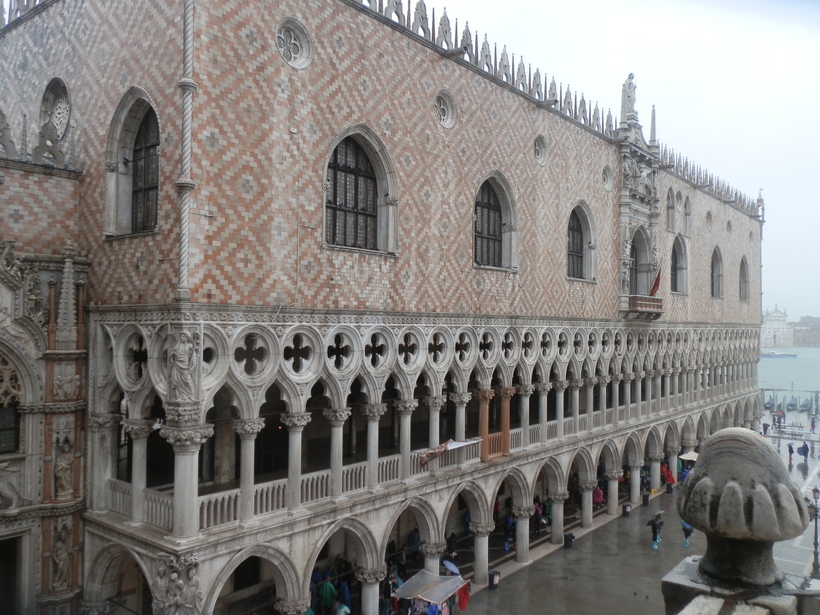
The palace was built in the Gothic style, which was fashionable at the time. Its architecture is very unusual: the massive upper part on thin legs, for example, at first even caused me a feeling of disproportion. However, this apparent disparity, the feeling of "lightness" of the lower part of the palace is created by numerous arched spans. Note that the upper part of the palace is not very rich in Gothic lace. The fact is that the decoration of its facade was carried out much later than the construction itself, at a time when more strict architectural styles came to replace the Gothic.
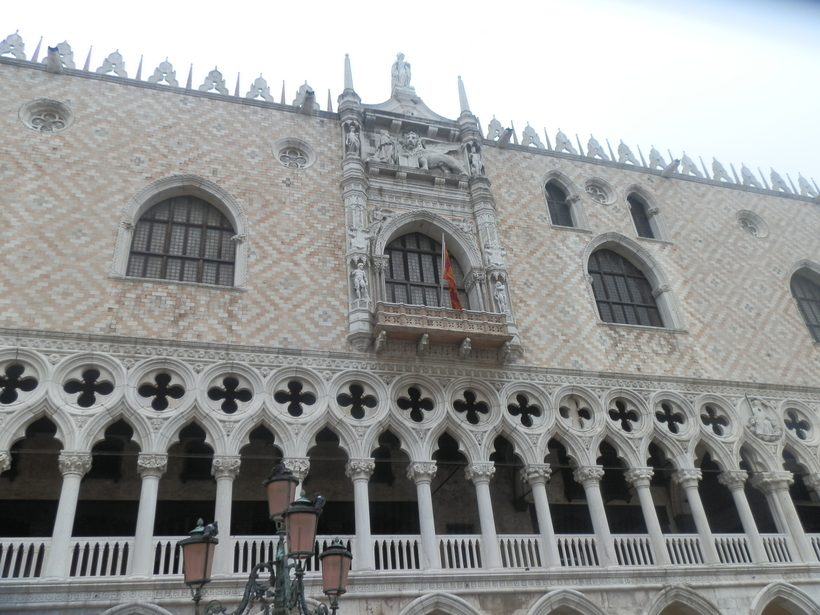
By the way, pay attention to the two red columns almost in the middle of the building. A certain sinister tradition is associated with them: either the death sentences were announced from this place, or the Doge watched the execution of criminals from here - versions differ.
I will note for clarity: despite the outward pomp and importance of the title of Doge, the real power of the supreme ruler of the Venetian Republic was extremely limited (except for very old times). In the later years of the republic, this was largely a decorative position - all decisions were made by the Grand Council, and the doge had to observe the ceremony and donate a lot from his personal bins for the good of the Motherland. But, being elected, the Doge ruled until his death.
The Doge's palace was often damaged by fires. It burned out especially badly in 1577. Then a serious debate flared up: to restore the palace in its former form or completely remake it. Fortunately, the first approach prevailed, otherwise we could study the current look of the palace only from old paintings.
After the fall of the republic in 1797, the palace housed various state institutions, first Napoleonic, then Austrian, and then unified Italy. In the 1920s, the palace was opened as a museum. I suggest we go there immediately.
Museum
In the old days, the famous Paper Gate served as the main entrance to the palace. Nowadays, they work only to exit the museum complex.
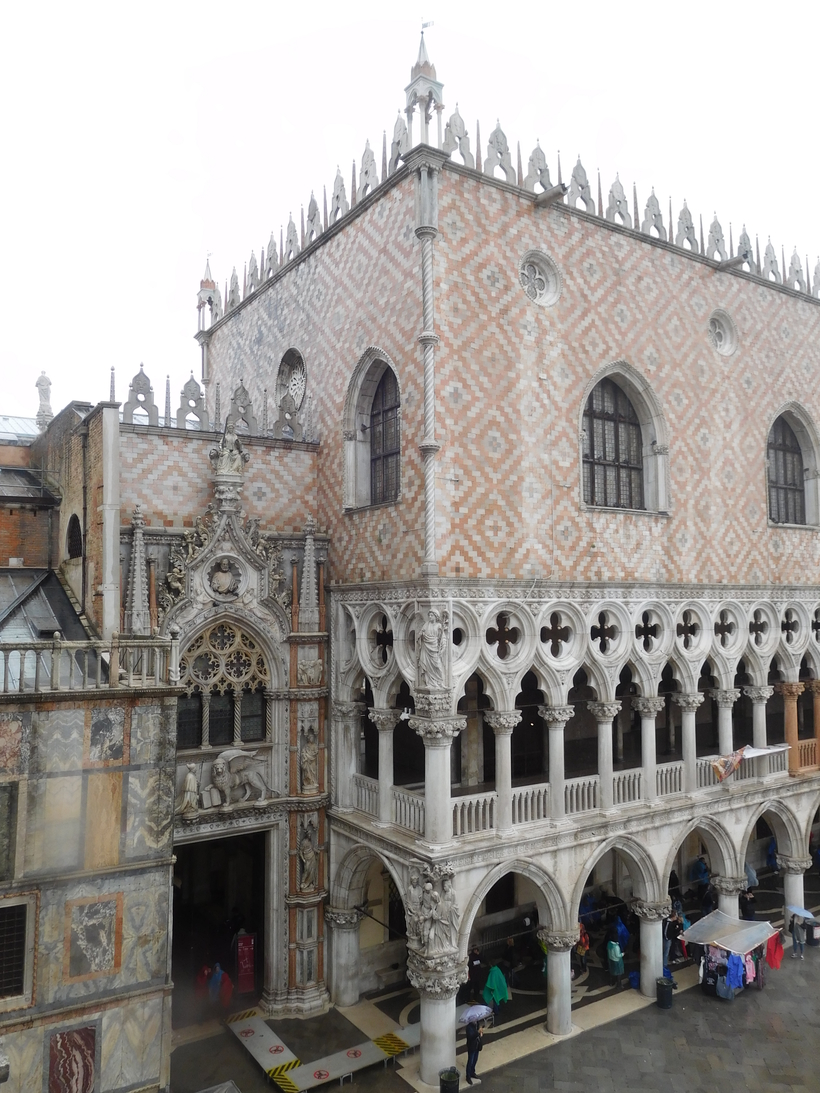
Ticket offices and the entrance to the museum are located on the side of the facade of the palace overlooking the bay. The lines here are usually small - especially compared to the crowds in front of St. Brand or Campanilo. Nevertheless, I recommend arriving early: by the middle of the day, the palace will be filled with people and it will not be very comfortable to inspect it, especially in the heat.
Buying tickets
The museum is open daily from 9-00 to 17-15 (from November to February - until 16-15). The ticket costs 20 EUR, it is the same for visiting the Doge's Palace, the Correr Museum, the Marcian Library and the Archaeological Museum. Tickets to these locations are not sold separately.
How long will it take to visit the Doge's Palace? According to my feelings, even if you walk slowly through the halls, without stopping anywhere longer than 1-2 minutes, you will be able to get around the entire complex in 3 hours. If you walk only along the most interesting places, but to linger at individual exhibits a little longer - the same 3 hours looms. Around this time, standard excursions around the palace are calculated, which take tourists who come to Venice by bus for 1 day. In principle, such an excursion is quite enough if your time in the city is very limited. However, if you are not traveling by tourist bus and have at least 3 days in the city, I would recommend taking your time to explore the palace. If, at the same time, you take an excursion, then you will be able to wander through the halls on your own after it ends. Then the inspection will take you 4-6 hours, but the impression of what you see will be more complete.
Courtyard
After passing the ticket office, we find ourselves in the courtyard of the Doge's residence. Such a view will immediately open before us.
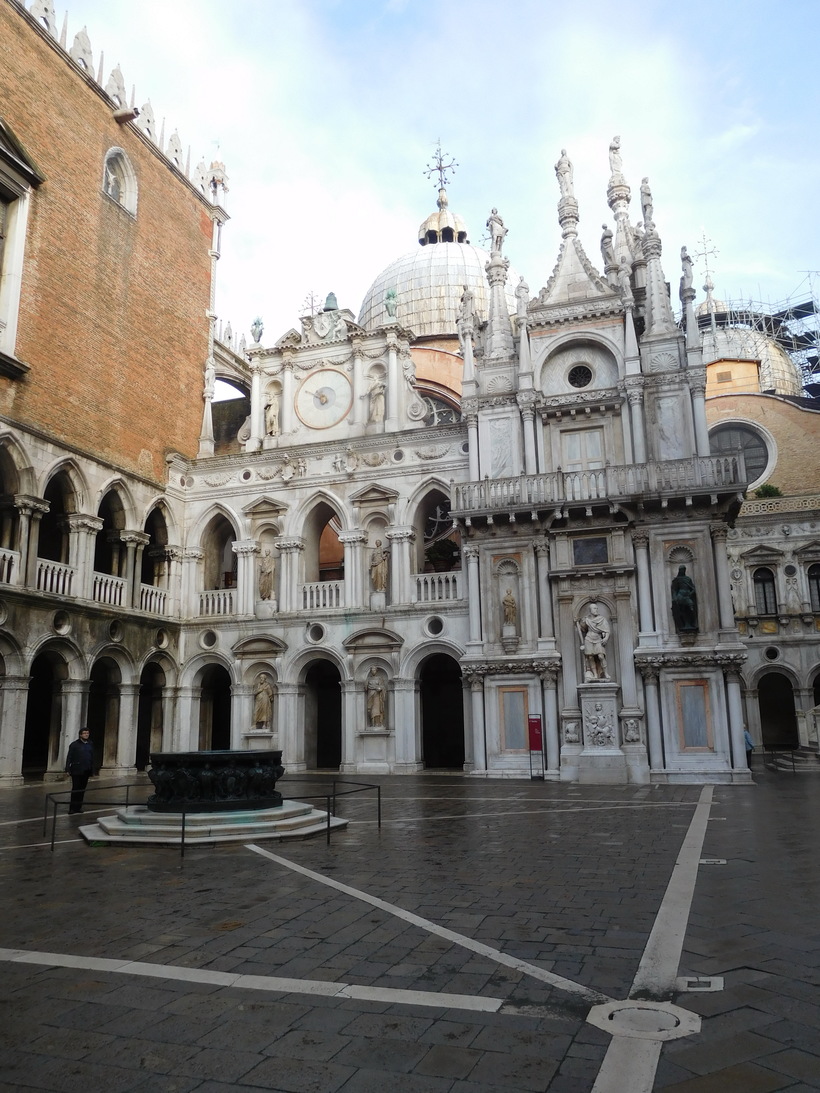
The gallery on the right houses a small archaeological exhibition, which will take a little time to explore. Let's go to the opposite side of the yard. I draw your attention to the wells - now they are not used, and once the water from them was considered the most delicious in Venice, water carriers carried it throughout the city.
So, we came to the entrance staircase of the palace - the Staircase of the Giants. The most important ceremonies of the republic were held there, including the wedding of the new doge - here a ritual cap, a symbol of power, was put on his head. On the sides of the stairs there are two statues: Mars and Neptune, which appeared in 1557, and in the back there is an exit from the museum through the Paper Gate, it's still early for us there. Time to climb the stairs and go inside the palace.
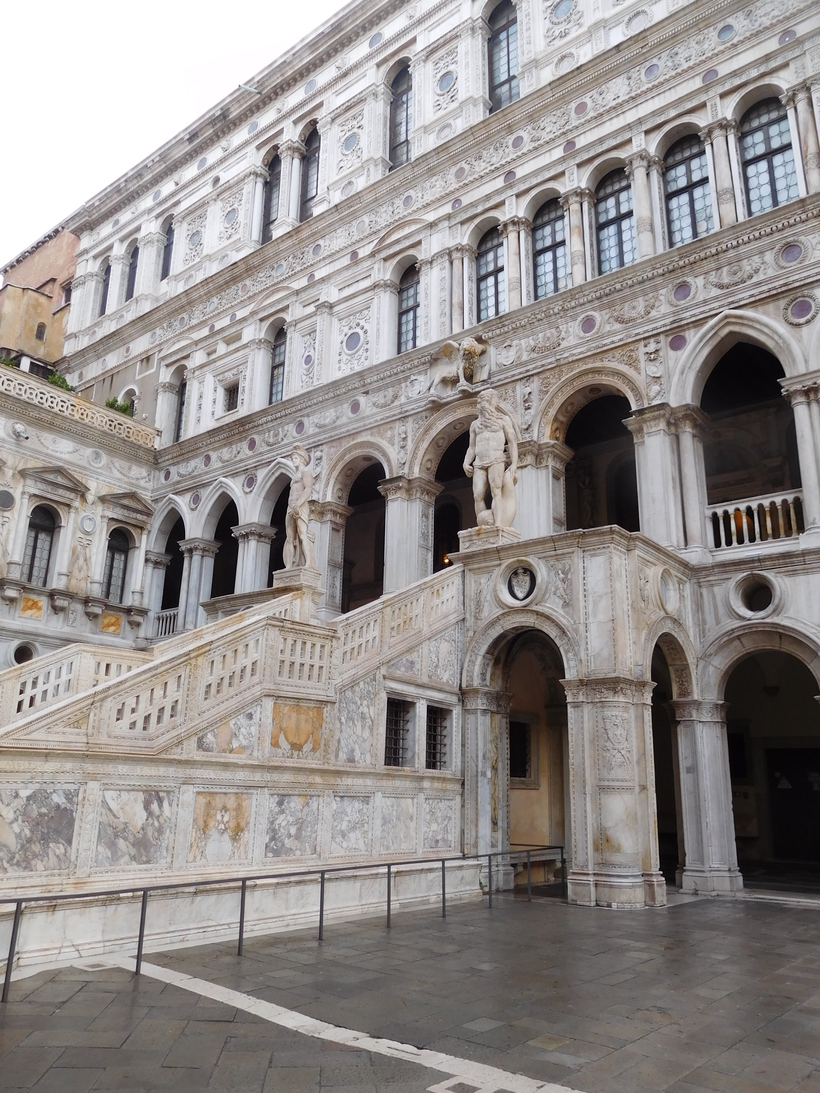
In principle, the rooms of the Doge's Palace can be explored in any order. During my first visit to the palace, I, for example, immediately went to the ceremonial halls. However, you can first walk through the Doge's apartments. If you started bypassing them, pay attention to the Hall of Cards with geographical maps and globes, the Hall of Philosophers and a small exhibition of paintings by famous masters - Bellini, Carpaccio, etc. If there is not much time to see the palace, I advise you not to linger in these halls - the most interesting is ahead.
State halls of the Doge's Palace
Along the Golden Staircase. First halls
In the ceremonial halls of the palace, visitors climb the Golden Staircase, just as noble guests, ambassadors of world powers and great people of the republic climbed it. It was impossible for ordinary people to walk this staircase - in the republic they strictly observed traditions established once and for all, there was even a special "golden" book with a list of noble Venetian families worthy of climbing the Golden Staircase. Before going upstairs, let's admire the view from the height of the gallery.
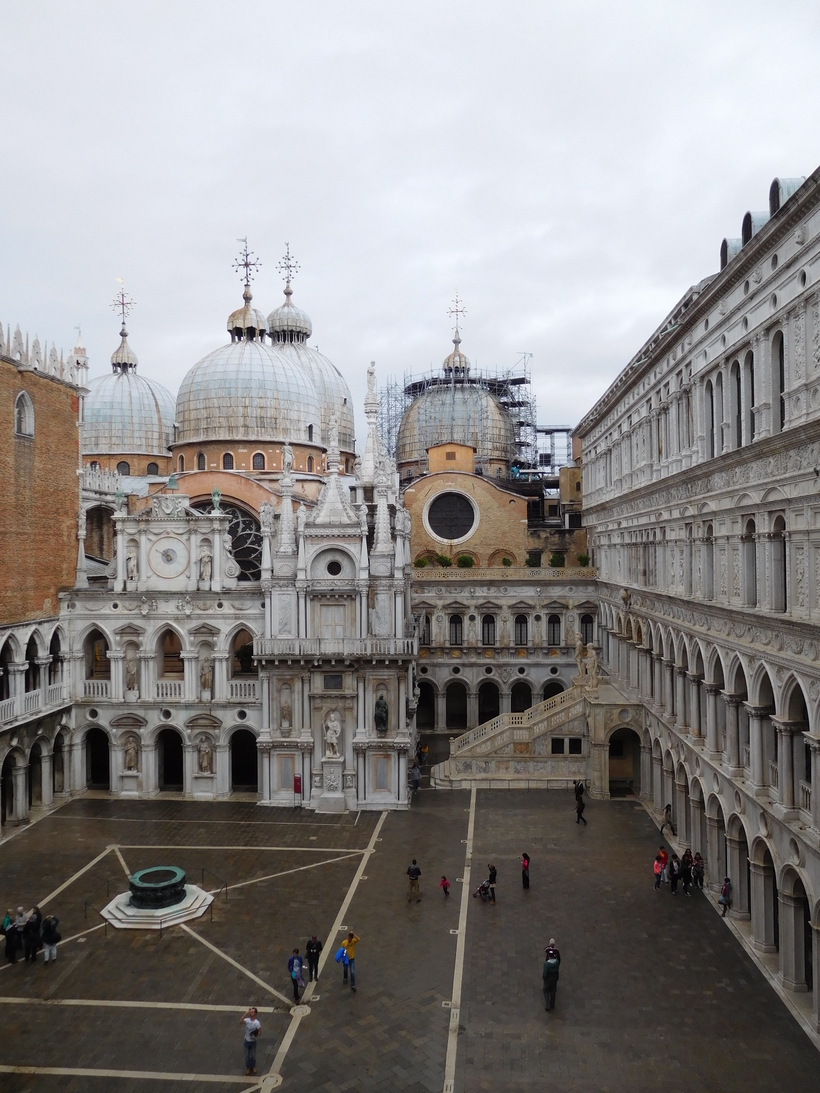
The very first halls - Hall of Four Doors, Hall in front of the College - I admired the wealth of decoration, and yet these were just hallways - places where visitors were waiting for a reception at the doge.
IN College Hall the doge and his advisers received foreign guests, their own diplomats and other important persons. The collegium included the Doge, his six advisers, the head of the council of ten, the supreme chancellor, and several other dignitaries. The political structure of the republic was complex - large and small Soviets, the Collegium, the Senate, etc. Most of all, the Venetian nobility was frightened by the prospect of a seizure of power by one person - hence the abundance of power bodies limiting the power of the Doge and each other. Partially it was the absence of strong power, its dispersion, and led to the disastrous end of the former empire.
All the ceremonial rooms are decorated with paintings by the best Venetian artists - Titian, Tintoretto, etc. The theme is the same - the glorification of the Venetian Republic, a description of its achievements and great victories. In the Hall of Colleges, my attention was drawn to Veronese's painting Sebastiano Venier after the Battle of Lepanto. Venier participated in the battle and was subsequently elected a Doge, but ruled for only a few months - he did not endure the grief from the fire of 1577 and the severe burnout of the palace.
IN Senate Hall I advise you to pay attention to the painting by Tintoretto "Dead Christ surrounded by two doges." Religious themes coexist with allegorical paintings, such as "Venice on the Throne". This room offers a typical view of the Venetian rooftops.
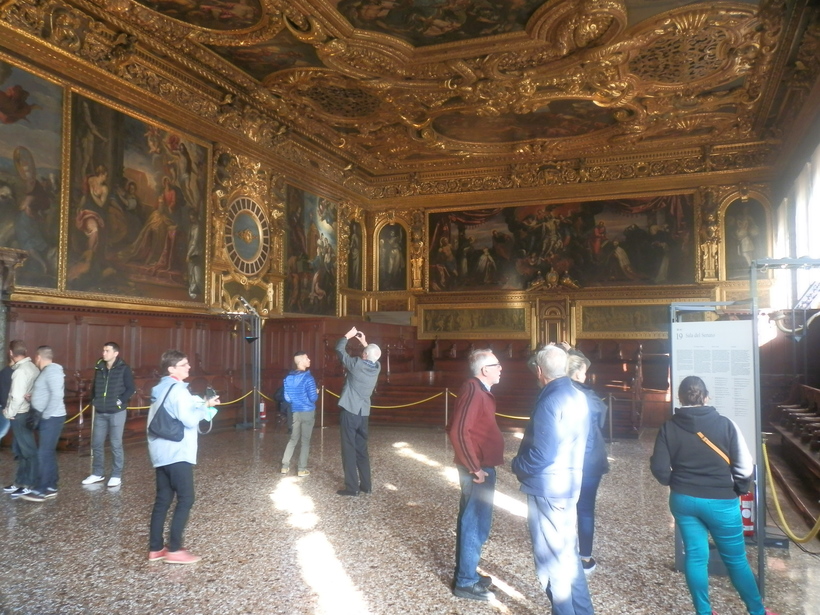
Compass room
Compass Room (Bussola) I was interested, first of all, not by the compass (although it is available), but by one of the few surviving boxes for denunciations.
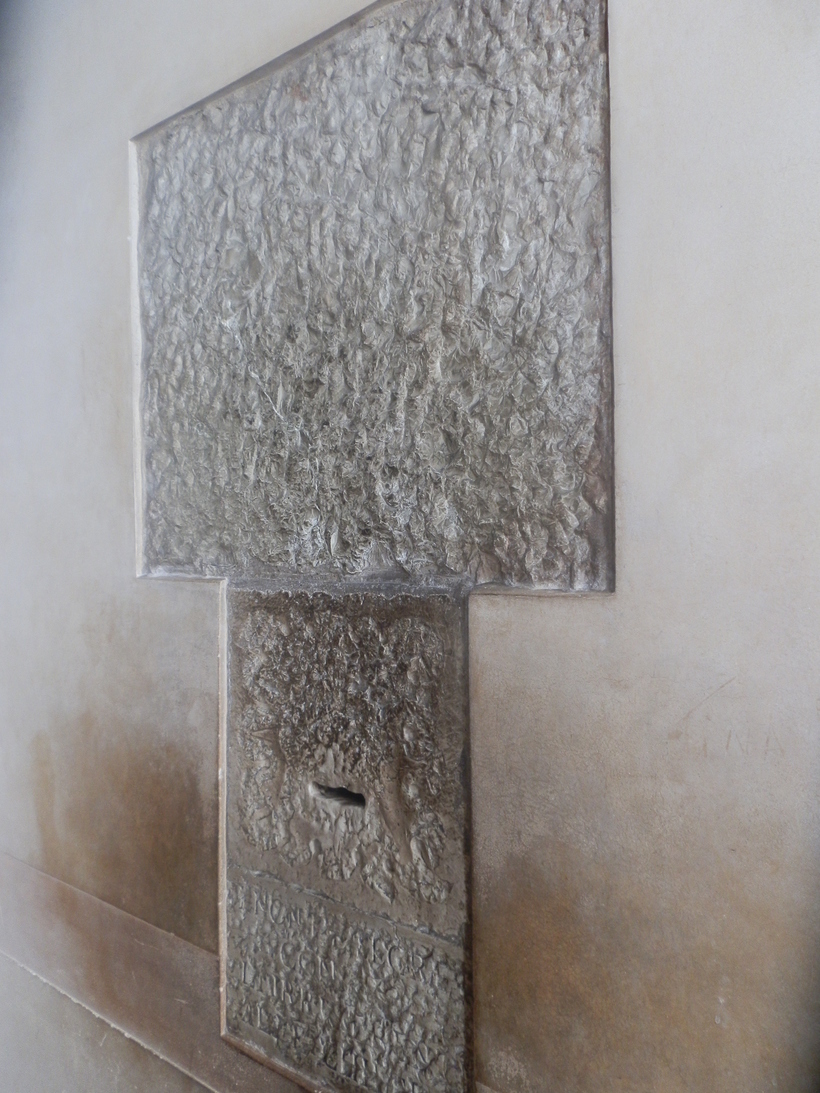
On the one hand, it is just a slot - a sort of mailbox, and on the other - a safe with a double door, which could be opened only by two people at the same time - each with its own door. Similar boxes in Venice were usually decorated in the form of a lion's mouth and were found throughout the city, not just in the palace. Apparently, the Venetians reported on each other very recklessly, the archives still contain a huge number of such pieces of paper.
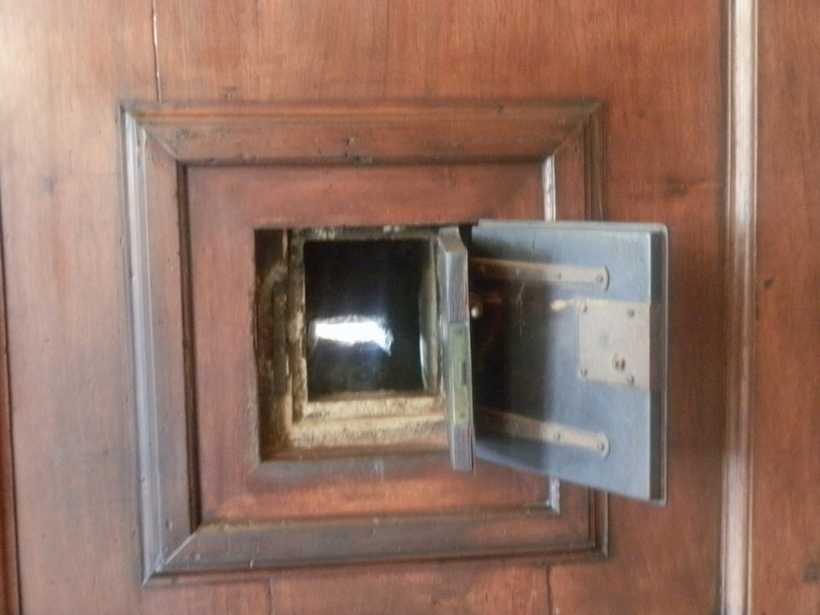
There were two secret doors leading out of the Compass Room, one of them leading directly to the prison on the top floor. In the courtroom, the accused often awaited sentencing. Also, with bated breath, people called in due to denunciation awaited the trial of their case.
All these cases were tried in Council Chamber of Ten
... The council was formed after the conspiracy of 1310 (to nip this in the bud) and was, in fact, the secret police of the Venetian Republic. In addition to 10 annually re-elected members, the Council included the Doge and 6 of his advisers. The glory of the Council of 10 was ominous. Now it is already difficult to say whether such a cruel arbitrariness was really going on there, as it was later presented by Napoleonic propaganda. If so, then it worked: for a long time in the mass consciousness the Republic of Venice began to be associated with total fear and denunciations, as well as with ruthless judges who stamp convictions in the Council of Ten hall and send prisoners under a "leaden roof" - this was the name of the old prison, cells which were located directly above the premises of the Council.
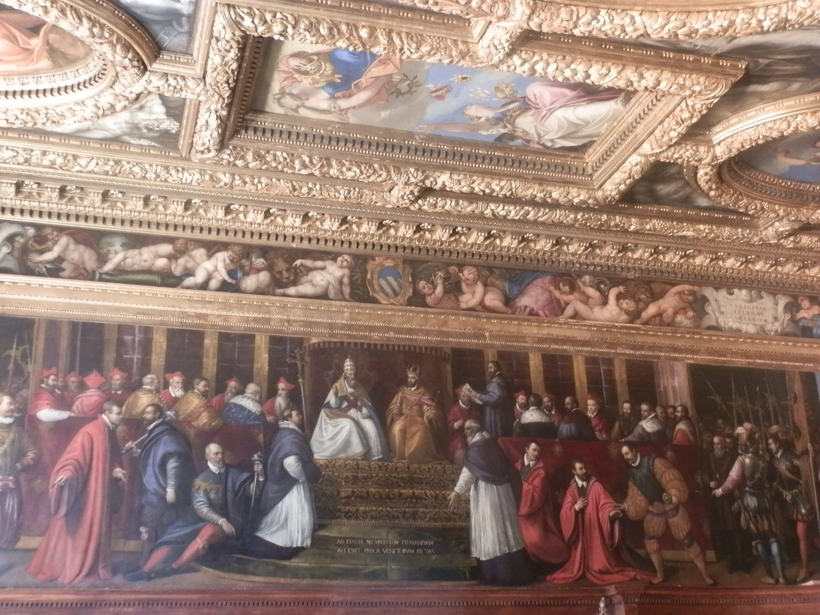
Armory halls
If time permits, I recommend to examine Armory halls ... Halberds, swords, pikes, crossbows, armor from different times are exhibited here - in a word, there is something to see. Formally, the weapon belonged to the Council of Ten and, they say, was always kept on alert - you never know what ... There is a feeling that the Venetians all the time lived like on a volcano. But for more than a thousand-year history of the republic, not a single serious riot or popular uprising has happened here - an amazing achievement.
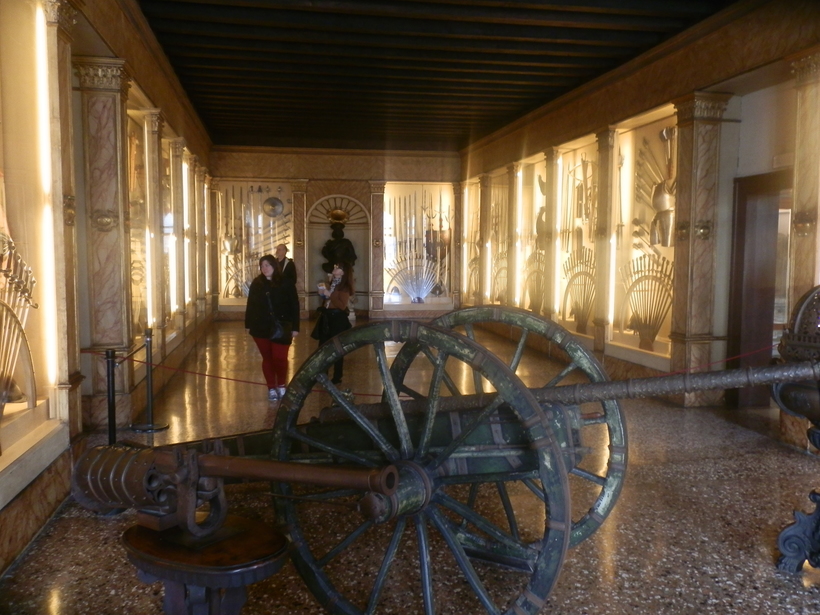
In the Armory, special attention should be paid to the equestrian armor of King Henry IV of France, donated to the republic in 1603. Yes, there were times when the most powerful rulers in the world were looking for the location of Venice.
After passing Council Chamber Soroka and several adjacent rooms, we will find ourselves in the main room of the Doge's Palace - Hall of the Grand Council. This supreme body of government of the republic sat here, and by the end of the 18th century it had grown to as much as 1600 people. Unsurprisingly, this government hall was the largest in Italy.
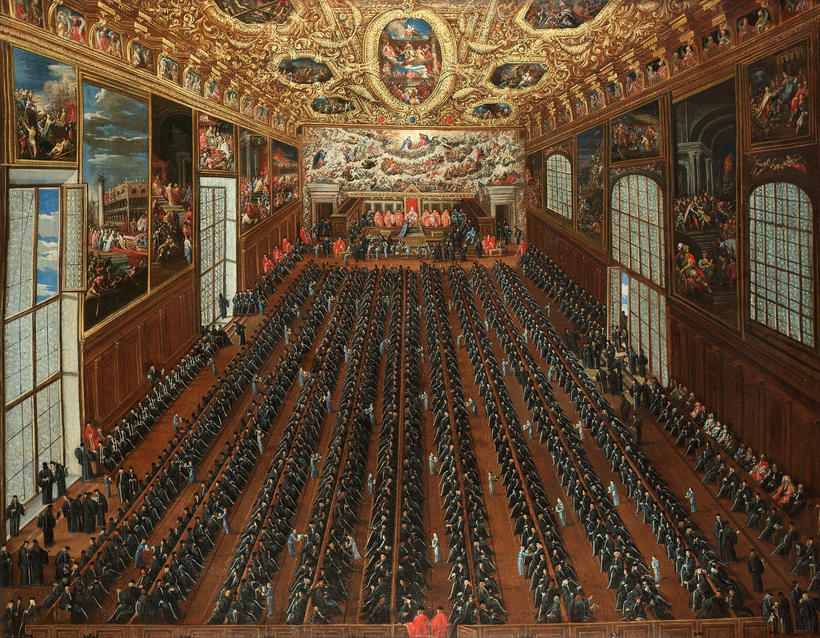
It was decorated by the best artists of Venice, but, alas, the fire of 1577 completely destroyed the old building with all the masterpieces. Of the masters of the old school, only Tintoretto and Veronese managed to take part in the restoration work. The most famous painting in the Hall of the Grand Council - "Paradise" - just by Tintoretto and his son. This one of the largest paintings in the world occupied the entire wall behind the Doge's throne.

The walls of the Grand Council Hall are decorated with large-scale canvases glorifying the glorious events of Venetian history. There are also 12 paintings describing the confrontation between Emperor Frederick Barbarossa and Pope Alexander III (their reconciliation took place in Venice, which later enjoyed the favor of both). I studied for a long time a series of paintings glorifying the fourth crusade, during which, with the active participation of the Venetians, Constantinople was taken and plundered. This page in the history of the republic can hardly be called glorious, although it was as a result of that campaign that it reached the peak of its power. Almost 600 years later, in many respects, it repeated the fate of Constantinople: the French removed a huge amount of treasures and cultural values from the city.
A separate seat in the Grand Council Chamber (as well as in an adjacent Voting Hall ) are occupied by battle canvases: the victories of the Venetians over Genoa, Milan and over the Turks under Lepanto were widely reflected in the work of artists.
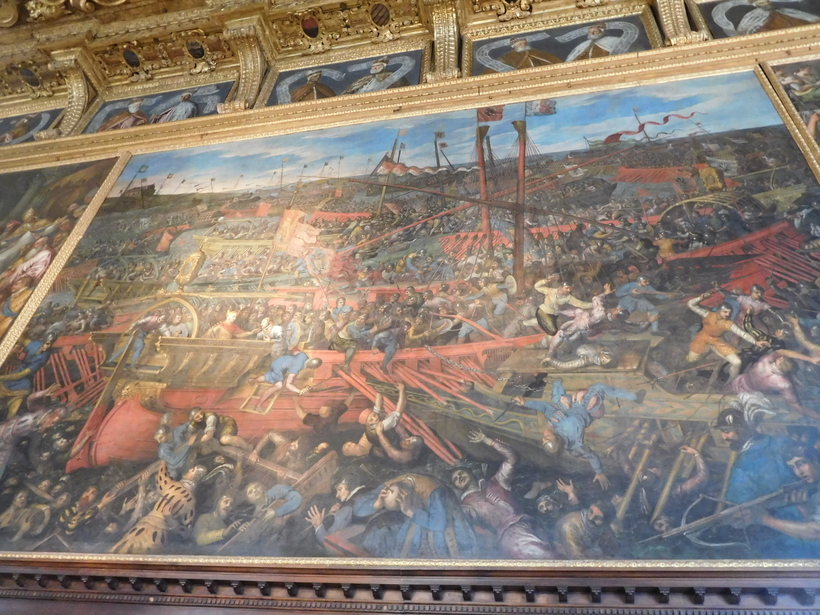
In the Hall of the Grand Council, one of the most ornate ceremonies of the Venetian Republic ended - the election of the doge. History probably did not know a more complicated system of elections. I will briefly retell it in my own words: first, 100 people choose 30 people, then these 30 choose 50 people, then those 50 choose 300 people, and so on. At the end of this chain, someone finally chose the Doge. By the way, portraits of all the Doges of the republic also adorn the Grand Council Hall. I deliberately found one place with a black drapery, instead of a portrait: on this place there was an image of the Doge Marino Faliero - the only ruler executed for treason (which is what the inscription tells us about).
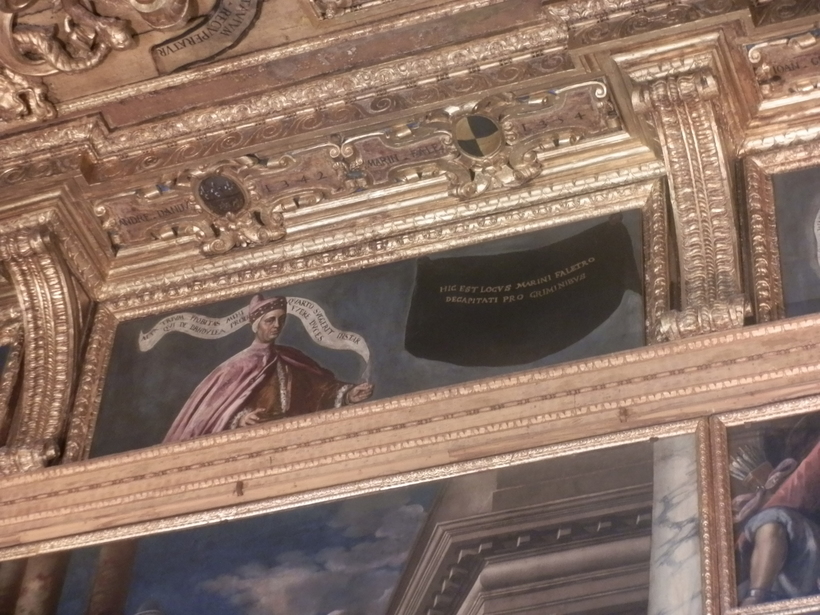
Over the Bridge of Sighs to the prison and back. The last halls of the palace
After crossing the bridge, we will be able to inspect the gloomy cells of the New Prison. It's not long to go around them - there is nothing remarkable inside, but the situation is indeed oppressive, I vividly imagined what it was like to be a prisoner.
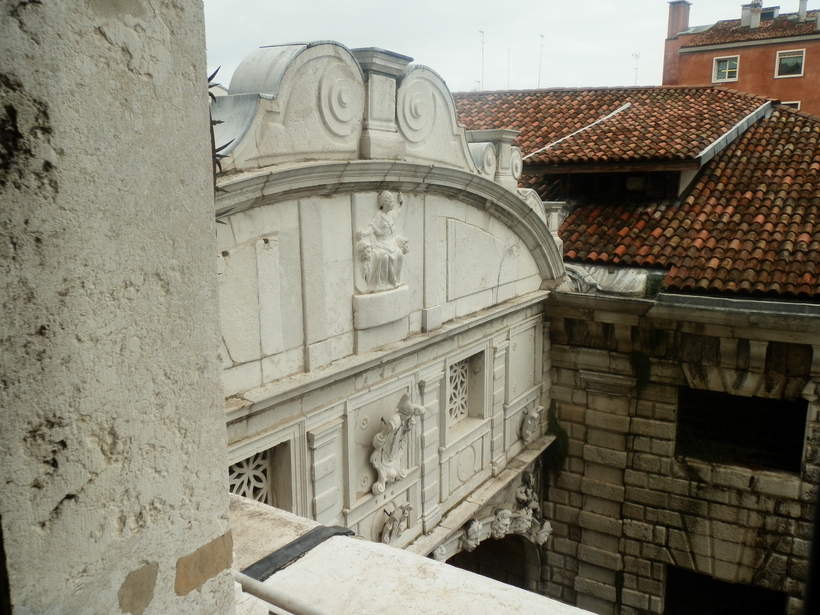
After examining the cells and the prison courtyard, we will get acquainted with a small exposition dedicated to the work of prisoners from not so long ago - the beginning of the 20th century (surprisingly, the prison functioned until the end of the Second World War). The creativity of the prisoners is represented by drawings and graffiti on the walls - indeed, many talented people have been here.
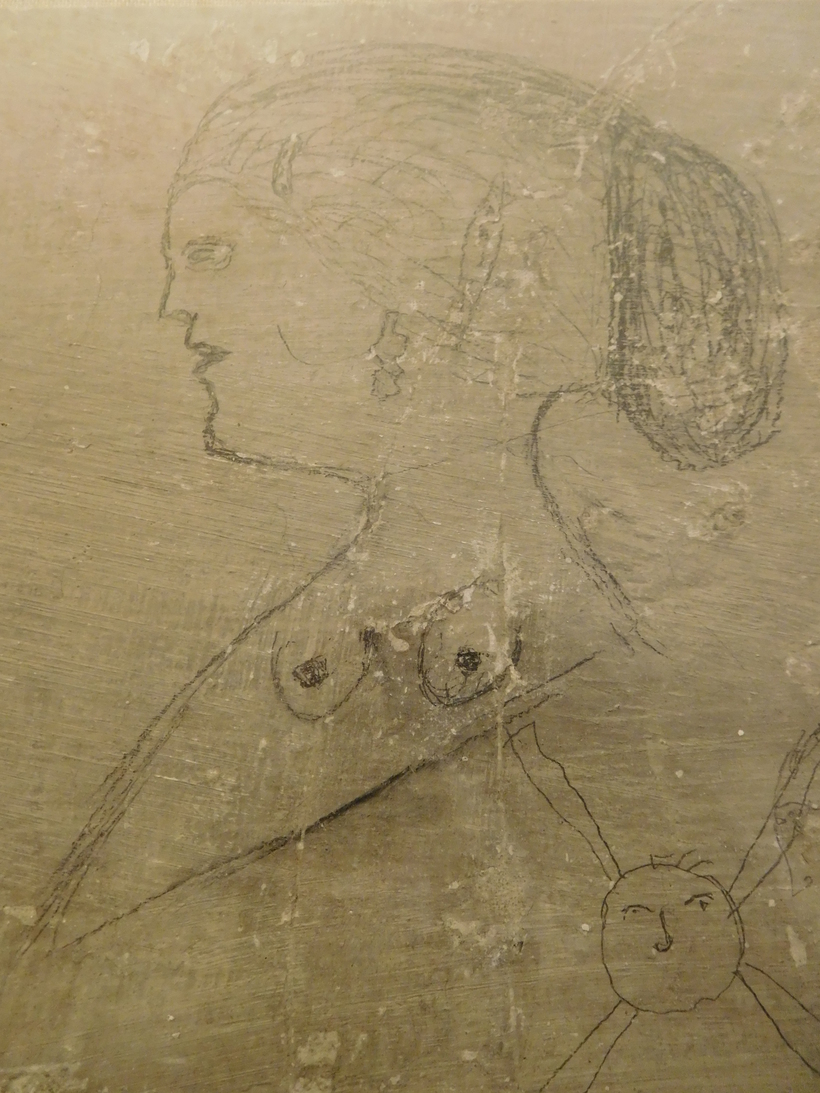
In the room in front of the bridge, there is a small archaeological exhibition showing objects found during the excavation of the foundations of the Campanilla San Marco. As you know, it completely collapsed in 1902, and in the process of its restoration, many items were found belonging to the most different periods of Venetian history, in particular, the remains of domestic animals.
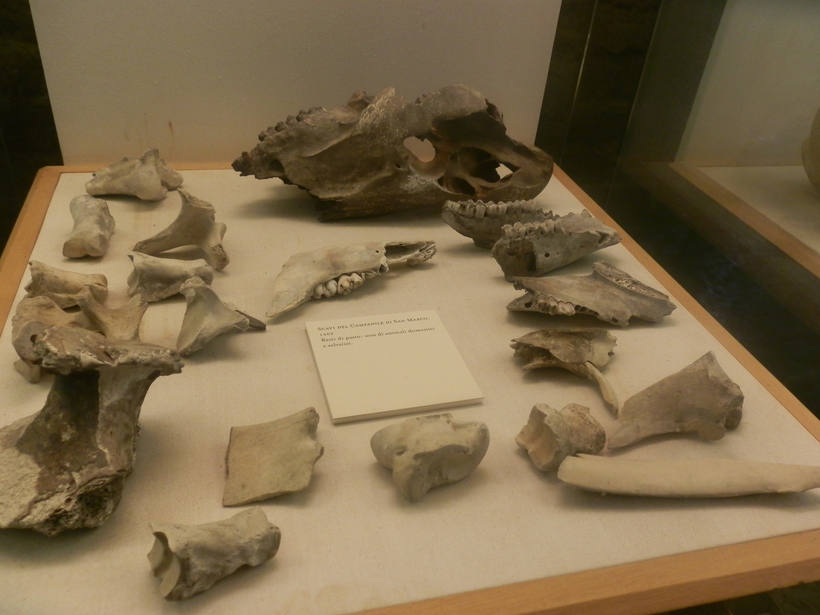
Having studied everything interesting, we return along the corridor of the Bridge of Sighs back to the palace. It remains to go through a few more small halls. Basically, these are the premises of various bureaucratic departments - notaries, censors, etc.
Soon we will enter a room with a souvenir shop, next to a cafe and toilets. It is not very profitable to buy souvenirs here, but there is a large selection of books on the history of Venice and the Doge's Palace in different languages, including Russian. Going down the stairs from here, we again find ourselves in the courtyard.
Here you can sit and relax on a bench and think about further plans for the day. If in the Doge's Palace we have already examined everything we wanted, we move to the exit to the Paper Gate.
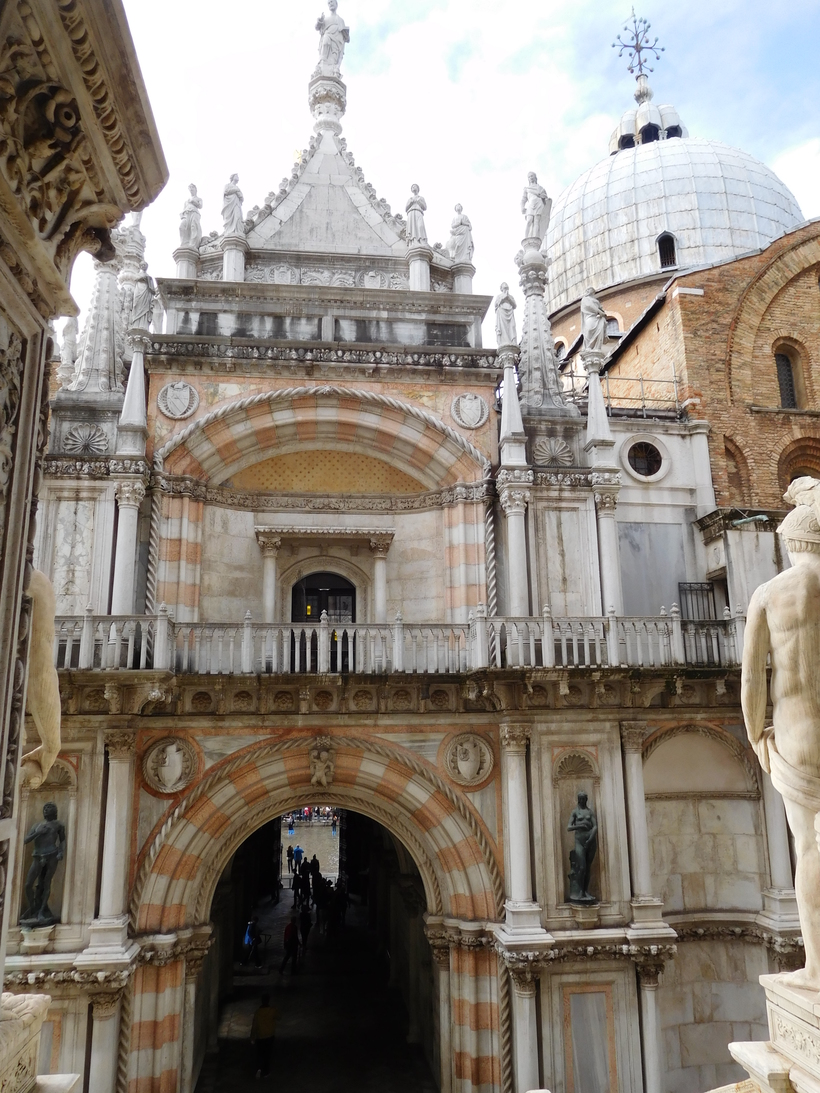
But stay a little longer near the Giants' staircase: next to it in a back street of one of the galleries stands the original sculpture of St. Theodore, trampling the dragon, is the one from the column in front of the palace. On the column, it was replaced by a copy long ago, but here we can appreciate its truly impressive dimensions and a very peculiar view up close.

It is believed that this composition was "collected" from the fragments of ancient Roman statues, which explains its lurid appearance. Especially good is the dragon, which looks more like a crocodile, who is tired of everything in this life.
After enjoying the masterpiece, we leave through the gate to Piazza San Marco.
How to get to the Doge's Palace
Most tourists get to the Doge's Palace by vaporetto (No. 1, No. 2, etc.). Get off at the San Zaccaria stop (1) and walk left along the promenade. When you cross the Straw Bridge (2), the Doge's Palace (3) will be on your right. If you are walking around Venice on foot and want to find the palace, head towards Piazza San Marco (4), since there are plenty of signs in the city. Once on the square, walk towards the embankment past the Cathedral of St. Mark (5) and the Doge's Palace (3) will be on your left.
There are many interesting things nearby. After a snack in one of the cafes on San Marco or in the immediate vicinity, you can go to the Correr Museum (6) - you already have a ticket. To get there, walk from the Doge's Palace and St. Mark to the opposite end of the square, keeping to the left. The museum is located in the building of the New Prosecutions, and it organically complements the exposition of the Doge's Palace: there are fewer large-scale paintings on the entire wall and halls with a rich history, but the life of Venice of different years is presented in detail - archaeological finds, documents, costumes, coins, etc. In addition, you can see a collection of paintings from the 12th-17th centuries, Greek and Roman sculptures from the 5th-4th centuries BC, as well as the famous library of Marcianus (7).
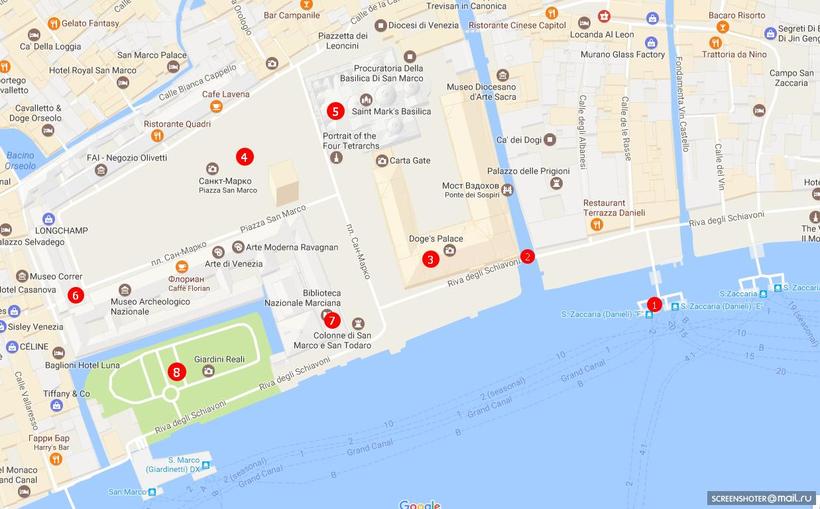
The main thing here is to correctly calculate your strength: you should not try to embrace the immensity. If you feel tired, relax in the garden (8) behind the library and walk towards the Rialto, enjoying the unique Venetian streets. In any case, this day will become one of your most vivid memories of Venice.
The Doge's Palace in Italy is the greatest architectural monument in the city. Once it was the seat of the rulers of the Venetian Republic, the most powerful, richest and most developed maritime state in the Middle Ages. And now there is a museum and crowds of tourists from all over the world. The main treasure of the palace for tourists and numerous excursion groups is its coolness (surprisingly, even in a forty-degree heat in Venice, you can rarely find air conditioning), which is very important in summer and ceiling frescoes with stucco molding. If you have a chill on your neck, come back another time: you will have to look mainly at the ceiling.
Over the years of its existence, the palace has managed to visit the seat of the government of the Venetian Republic, the seat of the Council and the Grand Senate, and the haven of the secret police. The palace has a lot of secret staircases and corridors into which tourists are allowed. But be careful, it is very easy to get lost!
The architecture of the Doge's Palace is very eclectic, since it was built and completed in different times for the entire glorious history of its existence. The existing one is already the fourth palace in a row. The first building was erected in Antiquity, judging by the excavations, it was a fortress. It was destroyed during the uprising in the 10th century. In 1106, the second burned down, and the third was destroyed by the Venetians themselves, as it did not correspond to the idea of the Venetians about the greatness of the state.
The current palace was built presumably in the 12th century. At that time, the usual castles with thick walls were not built in the city. The sea is the main fortification, and the well-trained fleet of Venice is its defense. The main architect of the Doge's Palace is Filippo Calendario, he significantly improved its appearance. For the final construction, Lombard and Florentine artisans were invited, most of the building was built and decorated by the Bon dynasty, Venetian marble craftsmen.
Peculiarities
The Doge's Palace is the only building in the world where the basic laws of architecture are resorted to only from time to time. At first, it seems illogical that the massive part of the palace stands on light, openwork arches, as if the palace is upside down. But despite this, every detail of the architectural composition is perfectly combined with each other. It is pleasant to look at the appearance of the palace. The ground floor open arcade gallery is a place to hide from the scorching summer sun. It is pleasant to relax here and enjoy the beauty of the external decoration of the palace.
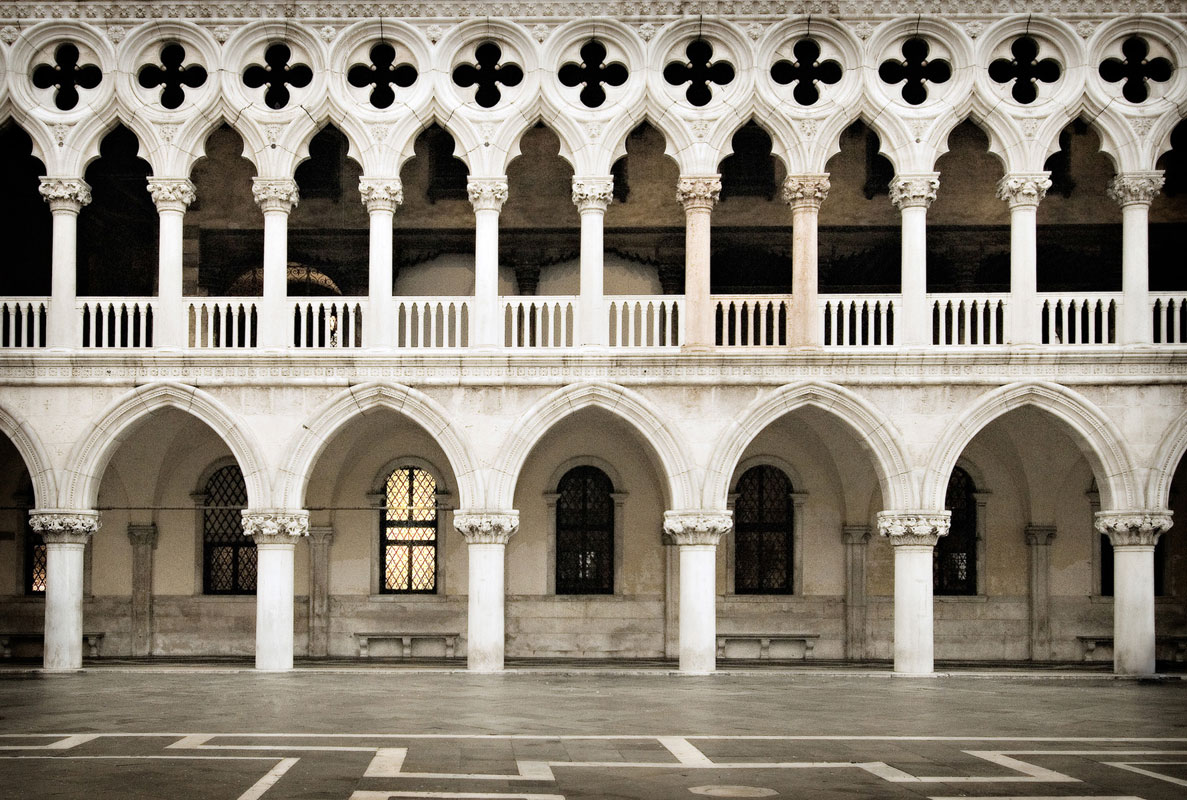
Doge Museum
You can do it in a few hours if you want to explore the palace on your own. If you have time and energy, be sure to go on a curious excursion "Secret Routes": secret stairs, torture chambers, piombi - prison cells under the roof (Casanova was thrown there without any accusations). In general, the police side of the Venetian state, which cannot be seen with regular entrance tickets.Once upon a time there was no stronger, richer and more influential state on the Mediterranean than the Venetian Republic. Centuries have passed, and now Venice no longer attracts invaders and traders, but millions of tourists from all over the world who want to see the city on the water in all its splendor. But even among the rich in curiosities of Venice, the Doge's Palace stands out.
Here and there - BlogoItaliano has already mentioned the Doge's Palace more than once. He rightfully entered, and also became the only representative of the city on the water. Therefore, sooner or later it was necessary to tell about the Doge's Palace in detail. Moreover, there is something to tell ...
History of the Doge's Palace in Venice
In the Middle Ages, the Venetian Republic almost completely ruled the Mediterranean Sea, and its possessions included Crete, Cyprus, the Ionian Islands, Dalmatia, Istria, Illyria (practically the entire territory of the former Yugoslavia). The Turkish threat did not yet exist, the Arabs did not have such a powerful fleet, trade with the eastern countries up to India was in full swing - Venice flourished.
At the beginning of the XIV century. it was decided to build a new Doge's Palace - a palace for the rulers of the republic and meetings of the Grand Council (legislative body), the Council of Soroca (judicial and executive body) and the Council of Ten ("secret office" of the republic). Moreover, it would already be the fourth Doge's Palace in Venice. The first building, erected on ancient ruins and representing, rather, a fortress, was destroyed in 976 during the uprising. The second burned down in 1106, and the third, built on the site of the burned one, already without towers and loopholes, was completely dilapidated and did not correspond to the idea of the Venetians about the greatness of the state.
Doge's Palace in Venice
The construction of the new palace took more than a century, from 1309 to 1424, but still up to the end of the 16th century. it was completed and improved, and after the fire in 1577, which destroyed almost the entire southern wing, the artists had to recreate all the interiors anew. Unfortunately, then Giorgione's masterpieces were irrevocably lost in the fire. And, fortunately, Veronese and Tintoretto received the order to restore the interior painting. By the way, Veronese was invited to the Doge's Palace more than once, and now his paintings can be seen in the halls of the Council of Ten (50s of the 16th century), the Grand Council and the Voting (1577, just after the fire).
Doge's Palace in Venice does not have a uniform style. The facade overlooking the lagoon and making the palace look like an inverted ship is a tribute to both late European Gothic and Byzantium, which included Venice for some time after the fall of the Western Roman Empire. Several gates lead to the courtyard, the most famous of which are the Paper gates, which received this name either from the fact that new decrees were once hung on them, or thanks to the scribes sitting near them who helped to draw up petitions.
The courtyard consists of several floors of openwork galleries. The northern wing of the palace, where the doge's private apartments were located, is decorated with statues of famous philosophers. And the statues of archangels in the corners of this part of the building symbolize peace, war and trade, that is, the main occupations of the Venetians.
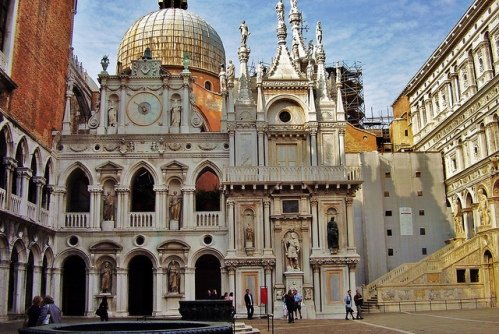
The inner courtyard of the Palazzo is decorated with figures of philosophers
The second tier of the Palace gallery can be reached by climbing the Staircase of the Giants (Neptune and Mars, already pagan patrons), on the upper platform of which the Doge's coronation ceremony took place. Examining the gallery and taking a photo of the Doge's Palace, it is worth photographing several times the capitals of the columns - real sculptural masterpieces - illustrating the history of Christianity and Venice.
Lions with wings and a book are everywhere - a symbol of St. Mark, the patron saint of the city and the republic. But the lion's faces and distorted faces with holes in the walls are not decorations, but boxes for collecting denunciations: the Council of Ten, elected for a year, and constantly exposing state criminals, worked with any "documents." True, only denunciations signed by the originator and witnesses were accepted for consideration.
The Golden Staircase (1538-59) leads to the inner rooms from the gallery of the palace. Until the abolition of the Doge Institute, in 1797, only members of the Grand Council could go there without special orders, whose names were inscribed in the Golden Book, which is kept in the room under the stairs.
The interior of the Doge's Palace
The first hall, where tourists usually get, but where it is already forbidden to take a photo, is Purple. Here procurators awaited the Doge's release - officials who were involved in the maintenance of buildings and wore purple robes. The walls and ceiling of the room are richly decorated with white stucco with gilding, a marble fireplace is decorated with the coat of arms of Doge Agostino Barbarigo.
In the Grimani Hall and the Lviv Hall, the main symbol of Venice- a lion with wings and a book. The Doge's Palace itself is also found in these paintings in great detail. The Hall of Philosophers is decorated with frescoes by Titian. Of interest is also the Hall of Maps, where material evidence of medieval ideas about the world is exhibited. These are, for example, copies of Marco Polo maps and maps with Tartary (the territory from the Caspian Sea to The Pacific and India).

Hall of the Grand Council in Palazzo Ducale
On the sumptuously decorated walls and ceiling of the Hall of the Colleges, one can see plafonds and panels by Veronese and the work of Tintoretto. It was here that the most important decisions of the government of the republic were once made. In the hall of the Magistrate, little-known paintings and triptychs by I. Bosch and other Dutch artists are exhibited. The Senate Hall is decorated with ceiling panels by Tintoretto.
Almost the entire southern wing of the palace is occupied by the Great Council Hall (54 × 25 × 15 m), which is considered the largest room in the world without internal ceilings and columns and has the most grandiose known painting - Tintoretto's Paradise (22 × 7 m).
Secret rooms of the Doge's Palace in Venice
The Doge's Palace has three floors, not counting the loggia floor, with many rooms and small rooms intended for the work of the countless Chanceries of the Republic and for holding meetings. Since 1923, paintings, weapons, and armor have been exhibited there.
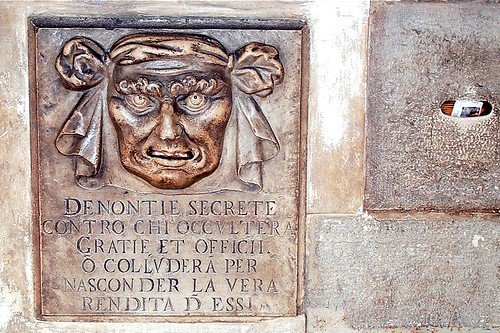
Denunciation Box at the Doge's Palace
However, not all of the premises of the palace have retained their original appearance. The French, who captured Venice in 1797, took many paintings by famous artists to the Louvre. Including the ceiling panel by Veronese "Zeus strikes vices with lightning" (now in its place is a copy) from the Council of Ten hall, where the Tribunal sat, passing sentences to criminals languishing nearby. Nearby - that is, on the floor above, where under the very roof was one of the old prisons - Piombi. The roof was covered with lead plates, and in the heat it heated up to unimaginable temperatures, and in the cold it literally chilled the soul, freezing the body.
In addition to Piombo, the Doge's Palace also had a prison Pozzi("Wells"), in the basement, at the water level in the canals. The criminals were kept under the roof and underground in inhuman conditions. At one time, Piombi's prisoners were Giordano Bruno and Casanova, who nevertheless escaped from prison, which no one had previously succeeded in.
By the way, despite the fact that there were not so few cells in both prisons, in the 16th century. a separate building was built to contain criminals. From the Doge's Palace to a new prison Karcheri separates only a narrow channel through which the the famous Bridge of Sighs, so named because through its barred windows, those led to the cell or to the execution could cast a farewell glance at the city and sigh, grieving about their fate. The secret rooms of the palace include, in addition to the prisons and the Council of Ten hall, the Council of Three (inquisition) hall, the torture hall and the execution hall (scaffold).

The Bridge of Sighs connected the Doge's Palace to the new prison
Tickets to the Doge's Palace
Another thing is that, even with one of the above tickets in hand, a very unpleasant incident opens up on the spot. It turns out in their scope not included those very secret rooms of the Palace and the Bridge of Sighs, which, exactly, are of the greatest interest to many tourists - there is always no end to those wishing to look at the camera of Giacomo Casanova or the famous torture hall of the Venetian Republic.
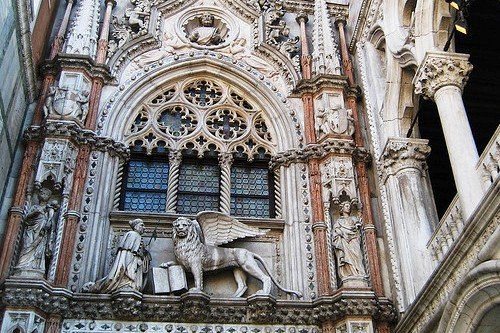
Saint Mark's Lion, Doge's Palace
These rooms are part of a separate 75-minute tour, which must also be purchased separately. Moreover, the number of excursions is limited, and on a normal day, no more than 3 of them are held.
Once upon a time the solution to the problem of visiting Secret rooms of the Doge's Palace was the introduction of the possibility booking excursions online... However, with the development of online shopping, this only exacerbated the situation with the availability of such tickets at the box offices on the spot (which is especially felt during the high tourist season). On the other hand, now everyone is on an equal footing, and if a visit to Venice without looking at the Casanova camera seems to you incomplete, then.
By the way, in 2016, BlogoItaliano made a separate video on how to book tickets to the most interesting sights of Italy online:
Opening hours and how to get there
The Doge's Palace is open to the public all year round, except December 25 and January 1. From April 1 to October 31, the Palace is open from 8:30 to 19:00. From November 1 to March 31, there is a shortened schedule - from 8:30 to 17:30. In both warm and cold periods of the year, the admission of visitors stops one hour before closing.
You can get to the Palace by:
From Piazzale Roma or Santa Lucia train station: Line 1 - Vallaresso or San Zaccaria stops, 2 - Giardinetti, 5.1 and 4.1 - San Zaccaria
From Lido di Venezia: Route 1 - Vallaresso or San Zaccaria stops, 5.2 - San Zaccaria
